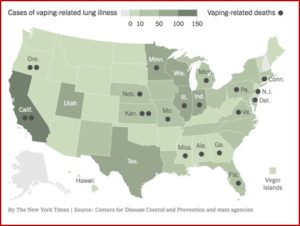
The clouds for the coming storm of adverse effects with e-cigarettes began to gather in the spring of 2019. Time Magazine reported the FDA was alerting Americans that vaping may be associated with seizures. Then in late May, researchers at the Stanford University School of Medicine published a study warning that the flavoring liquid of e-cigarettes may increase the risk of cardiovascular disease. After there was a report in the New England Journal of Medicine about an e-cigarette exploding in a teen’s mouth, reports of adverse effects began to fall all summer. The NEMJ said the teen had a circular puncture to the chin, extensive lacerations in his mouth, multiple disrupted lower incisors, a mandibular fracture and other injuries.
By late summer, the reports of possible cases of severe respiratory illnesses among people vaping more than doubled. Five people had died. In early September, the CDC suggested people should avoid using e-cigarettes. The NEMJ said e-cigarette products containing THC were the most commonly reported, in 84% of the study’s patients. But 17% of patients reported using only nicotine-based products, and 44% reported using both THC-based and nicotine-based products.
The findings in this report support several public health recommendations issued by the CDC. Since no single product or substance has been associated with the illness, persons should consider not using e-cigarettes while this investigation is ongoing, especially those purchased from sources other than authorized retailers (e.g., e-cigarette products with THC) and those modified in a manner not intended by the manufacturer. Adult smokers who are attempting to quit should consult with their health care provider and use proven treatments. Irrespective of these findings, e-cigarettes should never be used by youths, young adults, pregnant women, and adults who do not currently use tobacco products.
As of October 1, 2019, the CDC reported there were 1,080 lung injury cases associated with e-cigarette or vaping products from 48 states and 1 US territory. There were 18 confirmed deaths in 15 states. All patients reported a history of using e-cigarette or vaping products. Most said they had used THC-based products. Sixteen percent of patients were under 18; 21% were 18 to 20 years old. “No single product or substance has been linked to all lung injury cases. More information is needed to know whether a single product, substance, brand, or method of use is responsible for the outbreak.” See the CDC link for data on symptom onset and hospital admission with lung injury peaking in mid-August to early September.
According to NPR, the CDC’s principle deputy director, Dr. Anne Schuchat said: “We’re worried that there are plenty of risky products still out there. . . That’s one of the reasons we’ve intensified our warnings.” She said it was essentially impossible to know what is in the e-cigarette or vaping product you are getting, especially the THC-containing products. “The data we are getting does not suggest this has peaked.” She added that these are serious injuries in the lung, “and we don’t know how well people will recover from them, whether lung damage may be permanent.”
The Wall Street Journal reported experts think the symptoms are sparked by an inflammation or injury in the lungs from a chemical exposure. Researchers at the Mayo Clinic published a review of lung biopsies from 17 patients and said the injuries seemed more like the consequence of inhaling toxic chemicals rather than an oil. However, some of the earlier cases were diagnosed as lipoid pneuma, “which is a result of inhaling a fat or oil into the lungs.” Aside from the vaping link, federal officials are not sure of the exact cause of the outbreak. See the WSJ link for a short video on how it appears to be related to black market THC vapes.
The New York Times reported that as of October 4th, there were 21 confirmed deaths in 18 states. See the following map by the New York Times for cases of vaping-related lung illness and vaping-related deaths.
 Dr Howard Zucker, the New York State health commissioner, said this was a public health emergency:
Dr Howard Zucker, the New York State health commissioner, said this was a public health emergency:
It is undeniable that the vaping industry is using flavored e-cigarettes to get young people hooked on potentially dangerous and deadly products. While the court’s ruling temporarily delays our scheduled enforcement of this ban, it will not deter us from using every tool at our disposal to address this crisis.
Reflecting on his blog about the vaping illnesses and deaths, William White, the Emeritus Senior Research Consultant of Chestnut Health Systems, said new technologies that increase the efficiency of drug consumption by altering per episode and lifetime drug dosage, drug purity, or the method of drug administration may require “a fundamental rethinking of the risks associated with particular drugs.”
While the toxic effects of new drugs and new ways of using known drugs are usually identified early in their social emergence, the nightmare scenario would be a Trojan Horse that possessed few if any short term negative effects but devastating effects linked to long-term use. That is precisely the scenario that forced a radical rethinking of the effects of smoking tobacco over the past century. When toxic drug effects become quickly apparent before widespread use, mass public health damage can be minimized. In the case of tobacco smoking, short term studies would not have revealed smoking as the ticking time bomb that it is. We must be vigilant in identifying other drugs and patterns of drug consumption that may share a similar trajectory.
White’s concluding paragraph said those in the forefront of dealing with addiction have a unique opportunity to identify these threats early in their emergence. When we see them, “we can communicate what we are observing to public health and community leaders, and by so doing, arouse action to reduce the numbers of people exposed to such threats as well as get people already exposed the help they need as quickly as possible.” So, here is something new about vaping that just appeared this morning, as I was completing this article on October 8, 2019: “Vaping nicotine linked to lung cancer.”
News, Medical reported how a team of researchers at New York University School of Medicine caused mice to develop lung cancer. Yes, it is just an initial study with mice, but remember that if vaping is a relatively new way of using nicotine, research into the adverse effects of vaping is even newer. Mice studies are where researchers begin to investigate the problems. The study, “Electronic-cigarette smoke induces lung adenocarcinoma and bladder urothelial hyperplasia in mice” said that since given the fact that epidemiological data on the relationship between e-cigarettes (ECS) and human cancer may not be known for another ten years, the carcinogenicity of ECS was tested in mice. The researchers found that mice exposed to e-cigarettes for 54 weeks developed lung adenocarcinomas (9 of 40 mice, 22.5%) and bladder urothelial hyperplasia (23 of 40 mice, 57.5%). “We showed that ECS exposure of mice induces lung cancer and bladder urothelial hyperplasia.” The lead author of the study, Moon-shong Tang, said to News, Medical:
Tobacco smoke is among the most dangerous environmental agents to which humans are routinely exposed, but the potential of E-cig smoke as a threat to human health is not yet fully understood. Our study results in mice were not meant to be compared to human disease, but instead argue that E-cig smoke must be more thoroughly studied before it is deemed safe or marketed that way.
Then on October 11, 2019, an article was published in Nature that reported on various studies of adverse consequences of e-cigarette use. Some researchers are focusing on general lung damage and inflammation from toxic chemicals, others are concentrating on vitamin E acetate, an oily chemical suggested as a cause of the vaping illness. One researcher cautioned against hoping for quick answers; her initial findings took three and a half years to complete. The chief medical officer of the American Lung Association said science would eventually win, “But I don’t think it’s going to be as soon as people would like.”
Other researchers are working to categorize the chemicals contained in e-cigarettes. But the thousands of products and the culture of users who readily modify e-cigarettes and their contents makes this “a tough nut to crack.” One researcher said vapers are altering everything from how hot their e-cigarettes get to what chemicals are included in vaping cartridges, including in one instance, liquid Viagra. In the meantime, the vaping illness has sickened about 1,300 US vapers and killed 26. Brandon Larsen, a pulmonary pathologist, said everything is so rapidly evolving, that “I could tell you something today and next week it could be totally wrong.”
William White is right. We must remain vigilant to recognize potential long-term adverse effects with e-cigarettes in order to minimize mass public health damage. “It takes two decades or more for a life-time smoker to develop lung cancer. If tobacco smoke-induced lung carcinogenesis is a paradigm for e-cig carcinogenicity, then it will take at least another decade to have e-cig-related human lung cancer to show up.” It seems there is emerging evidence that the trajectory of e-cigarettes is leading us down the same path as tobacco cigarettes and it seems smoking e-cigarettes is a ticking time bomb. Do we really want to wait another ten years for the conclusive evidence of epidemiological data on the relationship between e-cigarettes (ECS) and human cancer before we take action to minimize the risk?





